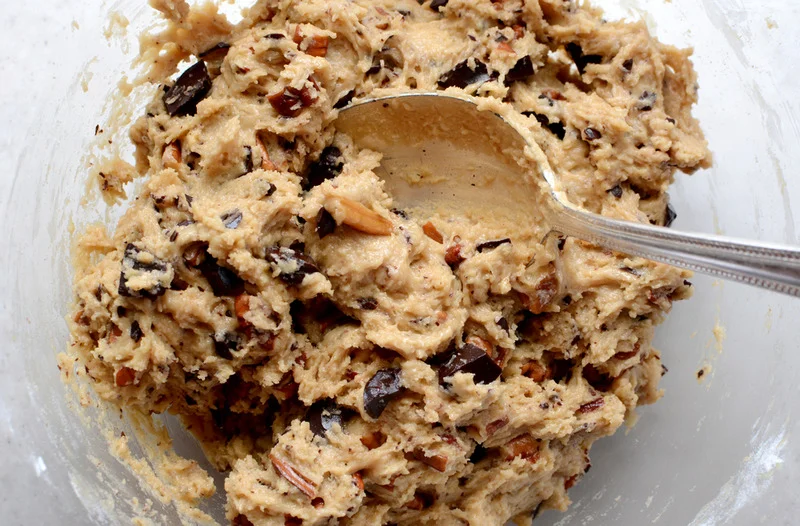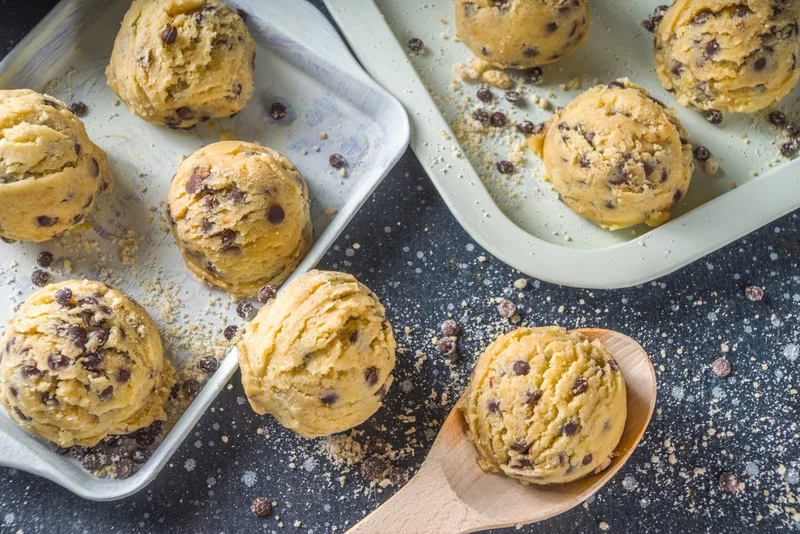Edible cookie dough has taken the culinary world by storm, redefining dessert options for food lovers everywhere. This treat presents a safe and scrumptious solution for those of us who can’t resist sneaking a spoonful of dough while baking. Let’s take a closer look at what makes an edible cookie dough recipe safe and satisfying.
Understanding Edible Cookie Dough
Edible cookie dough is similar to your standard cookie dough, but with a twist – it’s safe to eat raw. Let’s dissect this dough to understand its components.
Difference between Edible Cookie Dough and Regular Cookie Dough
Regular cookie dough isn’t safe to eat raw due to raw eggs and untreated flour, both of which can harbor harmful bacteria. Edible cookie dough eliminates this risk, creating a tasty and safe treat.
Key Ingredients in Edible Cookie Dough
The primary ingredients in most edible cookie dough recipes are flour, sugar, butter, vanilla extract, and chocolate chips. The absence of eggs and the process of heat-treating the flour make this dough safe to eat raw.
The Science Behind Safe-to-Eat Cookie Dough
What makes edible cookie dough safe to eat raw? The answer lies in the handling of its key components.
Why Raw Eggs and Untreated Flour Can Be Harmful
Raw eggs may contain Salmonella, and untreated flour can harbor E. coli, both of which can cause foodborne illness.
Heat Treating Flour to Kill Bacteria
By heat-treating the flour in the microwave or oven, you effectively kill any potential bacteria, making it safe to consume raw.
The Ultimate Edible Cookie Dough Recipe
Now, let’s get to the part you’ve been waiting for – a step-by-step guide to creating the ultimate edible cookie dough.
Step-by-Step Guide to Making the Recipe
- Start by heat-treating your all-purpose flour in the oven.
- Cream together butter and brown sugar until fluffy.
- Gradually mix in the treated flour, followed by vanilla extract and salt.
- Stir in chocolate chips.
- Enjoy immediately or store in the fridge for later use.
Tips for Ingredient Substitutions
Depending on dietary preferences or allergies, you can replace the butter with coconut oil, use gluten-free flour, or substitute traditional chocolate chips with a dairy-free version.
Variations on the Basic Edible Cookie Dough Recipe
This basic edible cookie dough recipe serves as a foundation that you can build upon with different flavors and mix-ins.
Making Different Flavors of Cookie Dough
By substitifying chocolate chips with different ingredients like peanut butter, white chocolate, or sprinkles, you can create a variety of unique and exciting flavors.
Incorporating Edible Cookie Dough into Desserts
Edible cookie dough can be used to enhance the flavor and texture of many other desserts.
Desserts That Can Be Enhanced with Edible Cookie Dough
From ice cream mix-ins to cake fillings, edible cookie dough adds a unique touch to a wide range of desserts.
Storing and Freezing Edible Cookie Dough
Store your cookie dough in an airtight container in the fridge for up to a week or in the freezer for up to three months.
Making Edible Cookie Dough a Healthy Treat
Edible cookie dough can be adapted to suit various dietary preferences and needs.
Options for Making Vegan, Gluten-Free, or Sugar-Free Cookie Dough
Replace regular flour with gluten-free flour, butter with vegan margarine, and sugar with a natural sweetener to suit your dietary needs.
Health Benefits of These Alternatives
These alternatives not only cater to dietary restrictions but also offer health benefits, like reduced cholesterol and refined sugar intake.
With this edible cookie dough recipe and tips in your culinary repertoire, you’re ready to delight in a safe, delicious, and customizable treat. Get creative and share your unique cookie dough creations in the comments below.
Frequently Asked Questions
Can I add cocoa powder to make a chocolate version?
Certainly! Add cocoa powder to the base recipe for rich chocolate edible cookie dough.
Why is a vanilla extract used in the recipe?
Vanilla extract adds depth and flavor to the dough, enhancing its overall taste.
How can I measure heat-treated flour accurately?
Use the same measurements as you would for untreated flour, but ensure it’s cooled post heat-treatment before incorporating it into the recipe.





